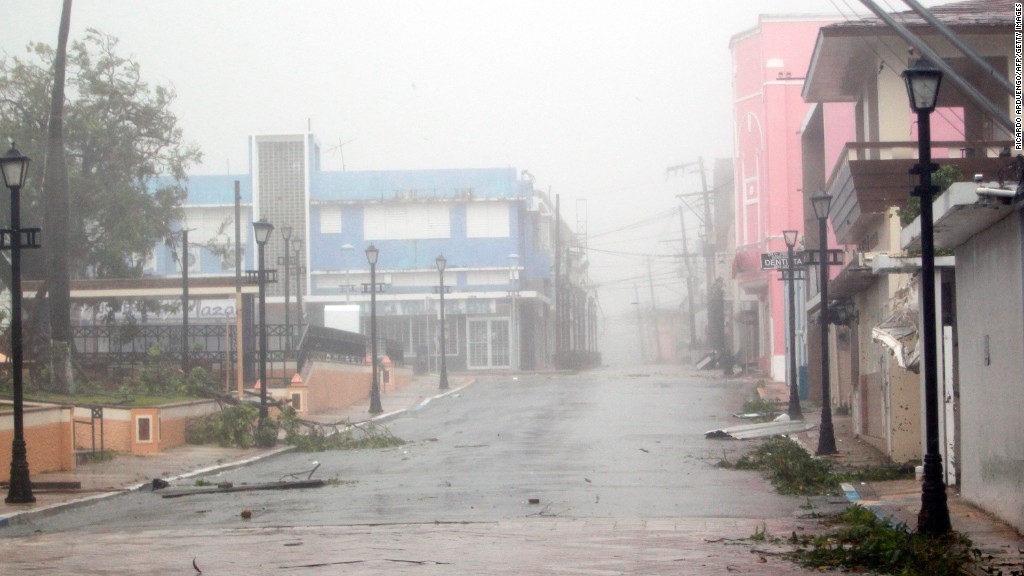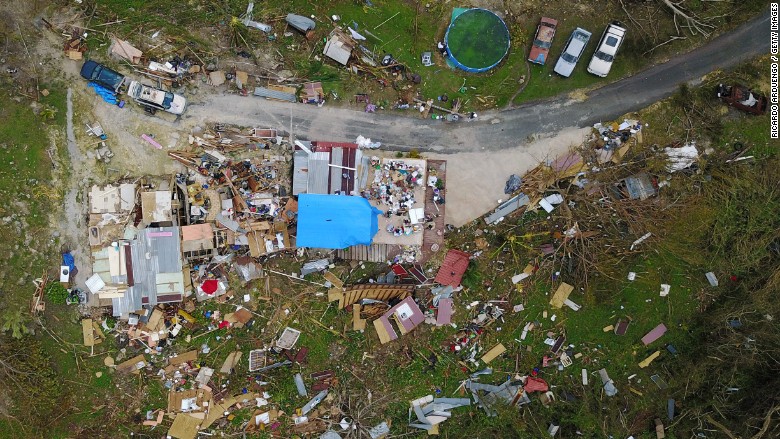
Puerto Rico is battling a massive economic and humanitarian crisis in the aftermath of Hurricane Maria.
It's not clear yet how much it will cost to rebuild. One conservative estimate puts total damage at $30 billion -- nearly a third the size of the island's entire economy.
Then there's Hurricanes Harvey and Irma.
Those storms will cost an estimated $150 billion and have already prompted billions in federal aid, insurance payouts and private donations.
So what does that leave for Puerto Rico?
Related: Hurricane Maria is a nightmare for Puerto Rico's economy
Insurance coverage
When it comes to covering damages, insurers are the first line of defense.
"People are expected to fund their own recoveries" with insurance payouts, said James Kendra, director of the Disaster Research Center at the University of Delaware. "FEMA steps in afterward, with supplementary assistance."
AIR Worldwide, which calculates the economic cost of natural disasters, predicts that Caribbean losses covered by insurance will be between $40 billion and $85 billion. More than 85% of those losses are in Puerto Rico.
But only 50% of homes in Puerto Rico have insurance that covers wind damage, AIR Worldwide said.
Flood damage typically isn't part of a standard homeowners insurance policy at all. Homeowners can apply for coverage from the National Flood Insurance Program -- but fewer than 1% of Puerto Rican households have done so, according to FEMA.
That means private and public insurance money won't be enough to cover all expenses.
Additionally, some people may decide not to pay for repairs at all — either because they have costly insurance deductibles or because they don't think it's worth it.

Government aid
The federal government can also offer help for localities, along with grants and loans to individuals.
Congress approved around $15 billion for hurricane relief after Harvey hit, and some of that will be used for Puerto Rico. The Trump administration is expected to send another disaster spending request to Congress in mid-October.
But it's not yet clear how much more money Puerto Rico needs, and it can take years to pay out all of the relief funds needed to rebuild.
The Federal Emergency Management Agency received about half of the $15 billion.
FEMA funds go directly to the areas hit by a disaster. For example, local governments that spend money giving their citizens food, water and shelter can be fully reimbursed for those costs in the first month after a disaster is declared.
The agency also helps people who lose their homes as part of a declared disaster, as well as those who either don't have any insurance or who have only partial coverage. It can also provide temporary financial relief, which can be used to fund necessities like temporary housing.
FEMA can approve up to $33,300 for people who have lost everything, but most don't get nearly as much. In reality the amount paid out is usually closer to $6,000, said Elizabeth Zimmerman, who was the associate administrator for the agency's office of response and recovery during the Obama administration.
It can take time for inspectors to fully assess the damage. But Zimmerman said FEMA has the ability to distribute some money immediately as electronic transfers, to help with gas, food or other emergency needs.
As of Monday morning, FEMA had $5.03 billion left in its fund until the end of the month. When the new fiscal year begins October 1, it will get another $6.7 billion, and the agency can request more down the road.
The Small Business Administration, which received some of the $15 billion, has paid out $511.6 million in home and business disaster loans for damage from Harvey and Irma. No loans have been approved yet for Hurricane Maria.
Corporate donations
The U.S. Chamber of Commerce this week released an initial tally of donations related to Maria relief that totaled $8.1 million.
And corporate donations are still coming in. For example, Starbucks (SBUX), Verizon (VZ) and Google (GOOG) have pledged a collective $1.75 million for Puerto Rico.
The value of other support is difficult to total. AT&T (T) and T-Mobile (TMUS) are waiving cellphone charges in affected areas, while several major airlines are flying in emergency supplies.
Companies have already given $224.9 million to cover damage from Harvey and Irma, according to the Chamber of Commerce. Some of those companies say their donations will also help areas hit by Maria.
Related: Puerto Rico has been in recession for 11 years and now it has no electricity
Celebs pitch in
Entertainers, athletes and other celebs are pitching in with their own recovery efforts.
Singer and actress Jennifer Lopez, whose parents are from Puerto Rico, announced Sunday that she would donate $1 million from the proceeds of her Las Vegas show to aid efforts.
Lopez also said Sunday that two planes filled with supplies would be on their way to the island. At the time, they were waiting for air clearance.
Hamilton creator and star Lin-Manuel Miranda, who is also of Puerto Rican descent, is trying to help too.
Miranda has for days been asking his Twitter followers to donate to the Hispanic Federation, a nonprofit that supports Latinos.
"Thanks to your generosity, first responders from NY are on a chartered plane" to Puerto Rico, he tweeted Saturday. "Don't stop now."
Five former U.S. presidents -- Barack Obama, George W. Bush, Bill Clinton, George H.W. Bush and Jimmy Carter -- are also teaming up to raise money for hurricane relief.
Their fundraising organization, One America Appeal, has been soliciting donations for victims of Harvey and Irma. It recently announced that it would expand its efforts to aid recovery in Puerto Rico and the U.S. Virgin Islands.


